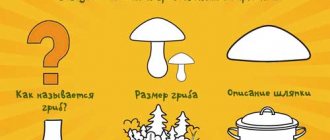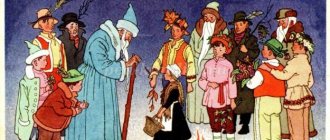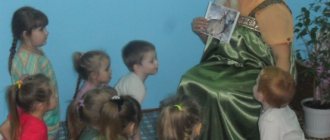Progress of the game:
On the front door of the group there is a poster with the name of the play.
I ask the children, pointing to the poster: “What is this?”
Let's read what is written on the poster.
I’m reading “Dear children and their parents, we invite you to the performance”
Where do you think you can watch the performance? (in the theatre)
What is theater? (This is such a beautiful building, artists perform there.)
Do you know who else works there? (make-up artists, costume designers, decorators, actors, director, cashier)
What is there in the theater? (auditorium, stage, ticket office, dressing room, buffet)
Tell me, how should one behave in the theater? (children's answers)
When the performance ends, what should the audience do? (Clap and you can give flowers to those who liked it.)
Guys, if you come to the theater, who will you be? (by viewers)
We distribute roles. You and I already know who the actors will be, so they will go to the dressing room to prepare for the performance.
"Cat house"
GCD "You can't play with fire"
Integration of educational areas:
“Cognition”, “Socialization”, “Safety”, “Communication”, “Artistic creativity”.
Program content.
1. Continue to familiarize children with fire safety rules, expand children’s knowledge about dangerous situations surrounding them in the house, on the street, in the forest; know the harm that comes from playing with fire.
2. To form in children an idea of objects that they absolutely cannot use.
3. Teach children to handle fire carefully:
— teach behavior in extreme situations; - learn to use the telephone.
4. Introduce the profession of a firefighter.
5. Development and correction of thought processes: attention, memory, development of speech, artistic abilities (depict the habits, behavioral characteristics of fairy-tale characters).
Development and correction of fine and gross motor skills.
6. Cultivate respect for the firefighter’s profession, a respectful attitude towards his hard work.
Foster independence and responsibility in children.
Methods:
gaming, visual, verbal, practical.
Techniques:
conversation, reading fiction, riddles, staging a fragment of the fairy tale “Cat’s House”, looking at illustrations, working with models, didactic games “Yes-no”, “Basic fire safety rules”, physical exercises and finger exercises “Firemen in training”, conversations, game-dramatization of the fairy tale “Cat's House”.
Equipment:
subject pictures and illustrations on fire safety, sets of numbers, illustrations of fire equipment, fire extinguisher.
Preliminary work.
- Learning poems and proverbs about fire safety.
- Review of fire safety posters.
- Reading works of fiction: “Fire”, “The Story of an Unknown Hero” by S. Marshak, “Fire Dogs” by L. Tolstoy, “Fire”, “In the Smoke” by V. Zhitkov.
- Looking at the illustrations for them.
- Conversation about the profession “Firefighter”.
Progress of the lesson
Teacher:
Children came to visit us, teachers from our kindergarten.
Guests:
When we went to your group, the postman gave you a letter and said for the 5th group.
Teacher:
Thank you, now we will see what kind of letter this is.
"Hello children! I am in hospital. I want to tell you how I got here. I was visiting Stepashka, we read books, drew, sculpted from plasticine, and then it got boring, and we decided to come up with a new game. And they found matches and began to play with them. At first we had fun and interesting. We really liked how the match struck the box, how the fire flared up, and then the fire crept up to our paws, we were afraid of getting burned and threw the match on the floor. And our paws and ears hurt. Doctors are treating us. Guys, don't trust matches, they can cause a lot of trouble. They are cunning and always ask for children’s hands.”
What a sad, sad letter.
Teacher:
Guys, why did Khryusha and Stepashka end up in the hospital?
Children's answers.
Teacher:
Do you play with matches at home? Well, that’s right, you are smart kids, and smart kids come up with good games for themselves.
Matches are not toys, but dangerous friends.
Teacher:
The harm of fire depends on the person. Adults know how not to quarrel with fire, and children need to learn this too.
Teacher:
Think about when fire is kind and useful?
Children's answers.
Didactic game “Fire is a friend, fire is an enemy.”
Children are offered cards with images of situations where fire is a friend and an enemy, where fire brings misfortune, and where fire brings benefit.
Teacher:
The power of fire is very great. Fire warms, makes cars work, launches rockets and spaceships. Food is cooked on fire. But when people forget to handle fire carefully, it becomes deadly. A fire is not an accident, but the result of improper behavior. And, in order to make life safer, at all times people passed on advice to their descendants. Very ancient “recommendations for safe behavior” are proverbs and sayings. Let's remember them.
Children say proverbs about safe behavior:
- Whoever avoids fire will soon get burned.
- Matches are not a toy, fire is not fun.
- Fires are extinguished with water, but prevented with intelligence.
- Beware of troubles while they're gone.
- The match is small, but the fire it produces is gigantic.
- A small spark burns cities.
Didactic game “What not to do.”
Teacher:
Guys, look at the pictures on the table, they are upside down. You need to take a picture and explain what you can’t do and why.
Well done guys, you did a great job! Listen to the riddle: Trouble! Trouble! Run here quickly! There is fire, and smoke, and fumes all around! There was a fire in our apartment... (fire)
Guys, what profession do people help put out fires?
Children's answers.
Teacher:
Look at this illustration. What does it show? What special did you notice? Why does a firefighter need a special suit?
Children's answers.
Teacher:
Right. The suit protects the firefighter from fire. What's on the fireman's head? Why does a fireman need a gas mask?
You said everything correctly: a fireman has a helmet on his head, it protects him from fire. A gas mask protects against smoke.
Teacher:
Right. When a fire occurs, it is very dangerous, and putting out a fire is not easy.
What do you think a firefighter should be like? Let's play a game, stand in a circle, I will throw you a ball, and you will throw it back to me and tell me what qualities a firefighter should have.
Children's answers:
Brave, Enduring, Brave, Courageous, Strong, Smart, Courageous.
Teacher:
What kind of people won’t be hired as firefighters?
Children's answers:
Cowardly, lazy, weak.
Teacher:
If there is a fire, what number should you call?
Children's answers:
“01”.
The teacher gives the children sets of numbers and asks them to put out the number “01”.
Teacher:
What should you tell firefighters over the phone?
Children's answers:
home address, full name, what is on.
Physical education moment
| If trouble strikes, never get lost. Act smartly. You need to dial “01” and call the firefighters. | - close both eyes - hands on your belt, turns left and right - walk in place - draw “01” in the air |
Teacher:
Smoke and fire are not good, so you know, quickly call on adults for help, and quickly call “01”: Firemen urgently! They will help! Now we'll play a game.
Game “Say the Word”
A coal fell on the floor, set the wooden floor on fire, Don’t look, don’t wait, don’t stand, But fill it with... (water).
If suddenly a fire breaks out, you must immediately call the fire department about the fire... (report).
Those who are not careful with fire may experience a fire. Children, remember that you cannot joke with... (fire).
We must fight fire, We are brave workers, We are partners with water. People really need us, so who are we?... (firemen).
If little sisters light matches at home, what should you do? Immediately those matches... (take away).
Teacher:
Now, guys, listen to what happened to the girl.
The mother went to the market and said to her daughter Lena: “Don’t touch the stove, Helen, it burns, Helen, the fire...”. S.Ya. Marshak
- What do you think could have happened to the girl if she had not listened to her mother?
Children's answers:
Fire. The house could have burned down, the girl could have died, suffocated from the smoke.
Teacher:
Don't hide under the bed - keep in mind that you can't just escape from the fire. Don’t stay in an apartment with a fire, but get out in an accessible way: tie your nose and mouth with a wet scarf, hurry to the front door through the smoke. G. Shalaeva, O. Zhuravleva
Teacher:
Guys, do you know how to put out a fire?
Children's answers:
Water, sand...
Teacher:
There is also a good assistant when extinguishing a fire, and what you will learn from this riddle:
If a flame suddenly breaks out, You have a reliable friend, Keep him at hand! Flame extinguisher, Smoke tamer - your friend... (fire extinguisher).
Teacher:
Indeed, any establishment, hospitals, etc. should have a fire extinguisher. We also have a fire extinguisher in our kindergarten. He puts out the fire with foam. Look at the picture.
Does everyone understand how to behave in the event of a fire?
And now we will consolidate the material covered so that you remember it for a long time. Children will recite poems about these situations.
Children
(read poetry):
For fun, for a game, don’t pick up matches. Don’t joke, my friend, with fire, so as not to regret it later. Don’t light the fire yourself and don’t let others do it.
Gas in the kitchen, a vacuum cleaner, TV and iron. Let only an adult turn it on. Our reliable senior friend.
Fire cannot be near where there is lubricant, gas, gasoline. After all, it is not in vain that we are told about them: “It is flammable”!
If trouble strikes, what should we do then? Never get lost Act skillfully!
If the phone is close and you can access it, you need to dial “01” and call the firefighters.
Teacher:
Guys, our friends Khryusha and Stepasha are in the hospital.
Let's draw funny pictures for them.
Progress of the performance.
After the performance ends, the actors bow.
Result: Which artist did you like best, and why? How did the audience behave? Did you like playing in the theater ?
And now the theater is closing, I suggest the artists go to the dressing room, and the audience restore order in the auditorium.
Dramatization of the fairy tale “Cat's House” Goal: Mastering children's verbal means of communication and developing their creative abilities. Objectives: Educational: 1. Expand and intensify.
A dramatization game based on the Indian folk tale “Princess Mak” in the preparatory group. Photo report Performance based on the Indian folk tale “Princess Mak”. Purpose: To develop in children of senior preschool age the ability to see beauty. A dramatization game based on the fairy tale “Puff” for middle-aged preschool children (photo report) I devoted the month of May to working on a project for middle-aged children “Folk Tales.” This project was also part of my circle work. Main. Game-dramatization based on the fairy tale by V. Suteev “Under the Mushroom” Summary in the middle group “Game-dramatization based on the fairy tale by V. Suteev “Under the Mushroom” Goal: Creating favorable conditions for creative activity.
A complex of morning exercises based on S. Marshak’s fairy tale “Cat’s House” in the senior group. Introductory part. Instructor: Guys, remember the fairy tale “The Cat’s House”? Remember when the cat's house caught fire? Let's go to a fairy tale and see who.
NOD “Cat House” based on the work of S. Ya. Marshak Summary of direct educational activities in the second junior group. Educational area “Reading fiction”.
Scenario of the regional New Year's holiday for educators based on the fairy tale by S. Ya. Marshak "Twelve Months" SCENARIO of the regional New Year's holiday based on the fairy tale by S. Ya. Marshak "Twelve Months" Voice-over. The most awaited one is on the doorstep.
Theatrical performance “The Tale of a Stupid Mouse” based on the fairy tale by S. Marshak The Tale of a Stupid Mouse. Scene one A mouse, a foal, little frogs, ducklings, and chickens run out. They sing "Loaf". Mother Horse and Chicken come.
Source






